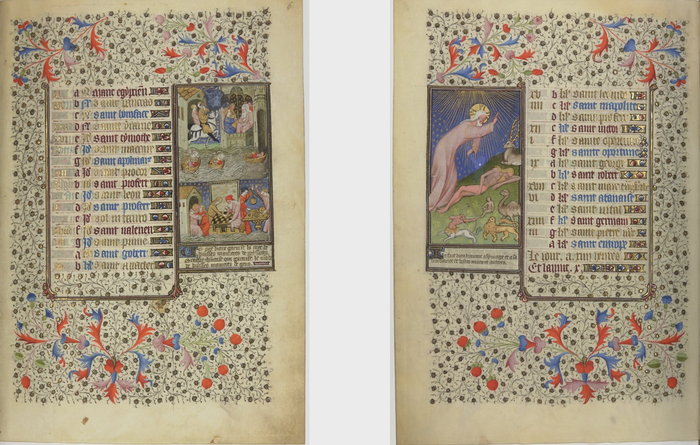From the Bibliothèque nationale de France comes Latin 1173, the Hours of Charles d’Angoulême, made in France in the Late 15th C. Charles was the father of King François I(r. 1515-1547), and is identified by his arms on f.53r. The Hours are Use of Paris, but the calendar has not been localized.
Most of the literature on this MS is not focused on the text at all, but either the miniatures. Many of these are originals by Robinet Testard, but several are actually prints by Israel van Meckenem (signed IM), which have been colored and embellished by Testard. The calendar is populated with quite distinct illustrations. The labors of the month are unusual and 9 of the KL initials are formed by humans, often in brown/blue clothing, contorted and posing with strange beasts. May (f.3r below) is a representative example, with the woman seemingly unconcerned by the dragon attacking her to form the arms of the “K”. What seems to be the labor is, in fact, two “wild men” jousting
In the content of the calendar there are both some unusual saints listed as well as an interesting bit of scribal error. The calendar starts out mostly full, 27 in Jan, but immediately starts to open up, with only 12 in February. In January some of the entries are quite rare, eg. the heretofore unique 40 Martyrs (4294) on Jan 9.
The calendar starts out triple-graded, blue/red/black, and is carefully graded, several multiple-saint entries are graded distinctly for each saint. In November, however, the scribe seems to forget that he’s triple-grading, and starts to use red and blue in simple alternation when there are high-ranks. This was less definitive in early November, All Saints (2850) in blue vs. All Souls (2993) in red, but becomes more evident as the month proceeds. In December it is unavoidable with strict alternation of red/blue in the Christmas (814) through Holy Innocents (823) block. Were this still triple graded, Christmas, in red, would be outranked by the Holy Innocents and even St. Barbara (853), both in blue.
(DB Id: 278)
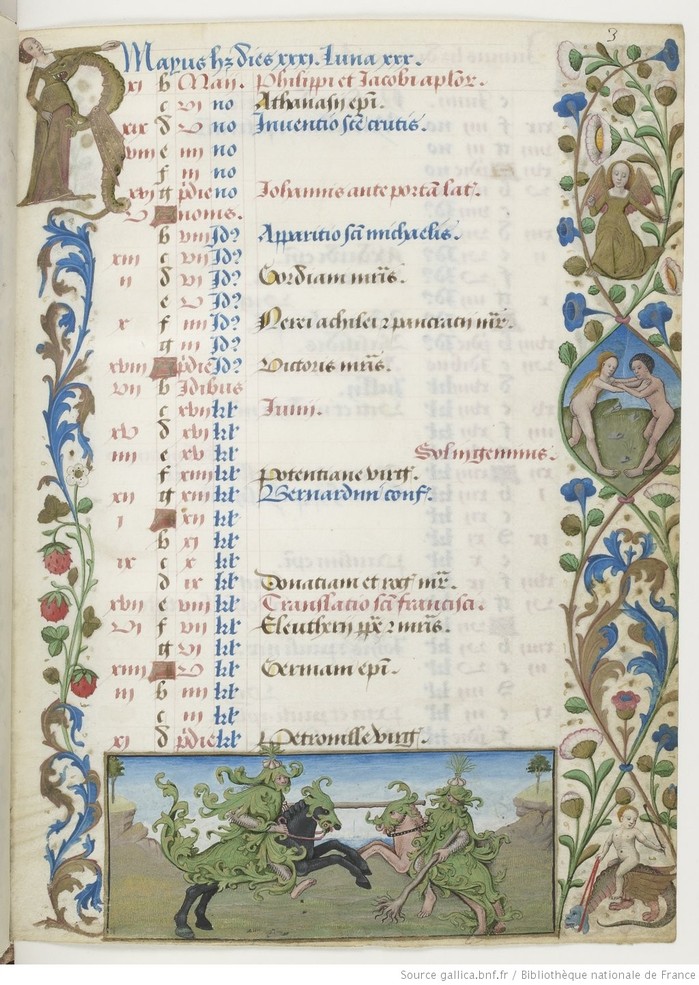
Catching up on some backlogged additions to the database.
First is up is Bibliothèque nationale de France, Latin 1171. This Hours Henri IV is unusual for the golden parchment used throughout the manuscript, every page of text is a matte gold, perhaps shell gold. The miniatures are done in a semi-gresaille style, with touches of gold and purple, and brown wash.
The calendar is complete and has an interesting scribal trick to handle the color of the entries. The feasts alternate red and blank ink evenly, with high-importance feasts identified by a larger, white, capitol letter to start them. This solves for the desire to keep the perfectly regular color pattern without loosing the indication of important feasts, cf. DB Id 266. There is some ambiguity in the Vigils, which are indicated with a white paraf mark before the word. I am treating these as “high” importance, but the paraf could indicate a medium range. Since these only appear on the Vigils, and appear on all of those, there is little additional data to use.
The calendar entries are in French and there are a surprisingly large number of unidentified saints, including some with unique names, Saint Feulgent on March 18 as an example (see f.2r below)
(DB Id. 162)
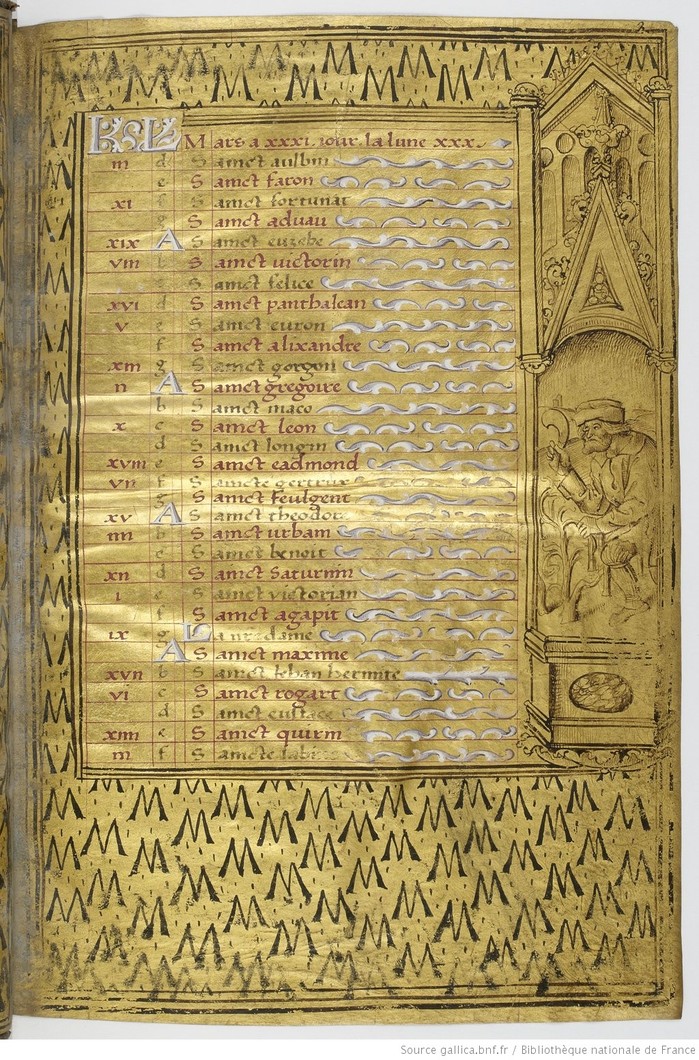
Bibliothèque nationale de France Nouvelle acquisition latine 3093 is one of the multiple fragments of a complex manuscript, which was owned and possibly comissioned by Jean, Duc de Berry (yes, that Duc de Berry). The BnF fragment, called the Très Belles Heures de Notre-Dame, is mostly Book of Hours content, but the manuscript originally contained a Psalter and some of a Missel as well. Even without touching on the complex history of creation and illumination, the calendar is interesting in it's own right. The entries are mostly standard for Paris, though there are a large number of local bishops specified with their See, (see Sts. Savian and Potencian, October 19, on f.Vv below. Their see of Sens is recorded). There are also some of the specifically Parisian royal feasts, including both the Crown of Thorns (Aug. 11) and Relics of St. Chapelle (Sept. 30) and multiple kings and queens.
The coloring seems to have no pattern at all, sadly. There are 4 colors used, red, blue, pink (distinct from the red, perhaps a faded purple) and black, which might be lost gold, and many of the feasts have size indications in the right margin (3 or 9 lessons, or Annuale), but there seems to be no correlation between color and rank. High-rank feasts are often blue, but in November, where the month is mostly full, it seems to be a simple pattern (blue is roughly every 3rd feast), and St. Andrew, an apostle, is pink.
(DB Id: 197)
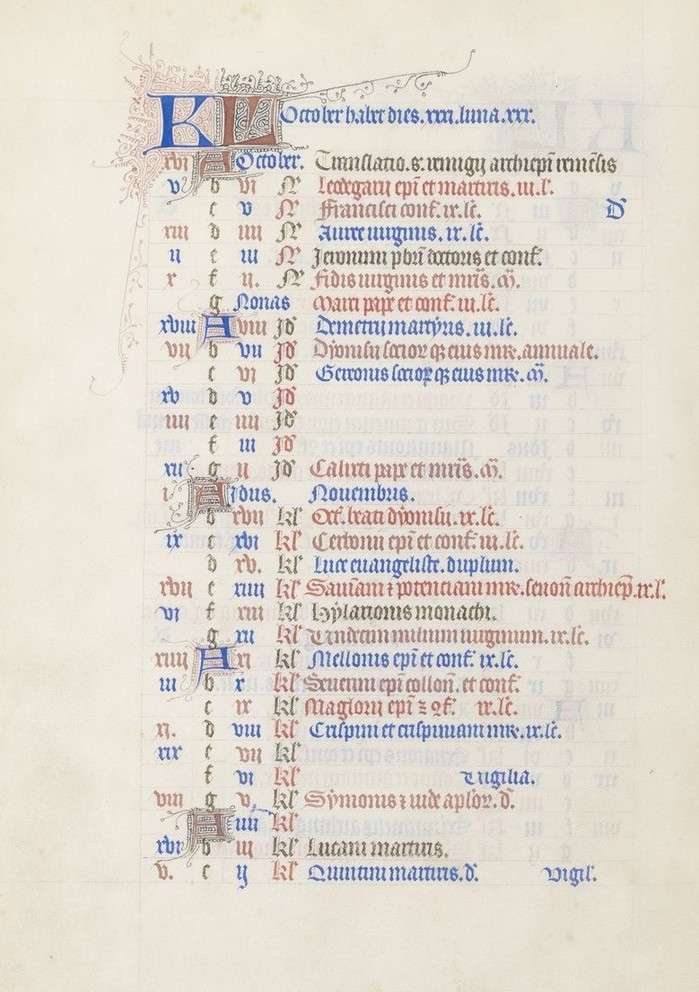
Bibliothèque nationale de France Nouvelle acquisition latine 3209 is another slightly odd, recently acquired Book of Hours. This one is Use of Rome, but calendar specific to Autun, and dated to right around 1450-1460. The calendar has several very specific-to-Autun entries, such as the “Revelation to St. Lazarus” on October 20(see in red f.5v below) and the “Dedication of the Church of St. Lazarus” on December 30th. The Cathedral of Autun is dedicated to St. Lazarus and has many of his relics, though in the early Middle Ages there was some confusion as to which Lazarus they had. This calendar is also somewhat unusual in calling out the Egyptian Days, which were thought to be especially inauspicious (see Oct 3 and 23). (See in the DB: 143)
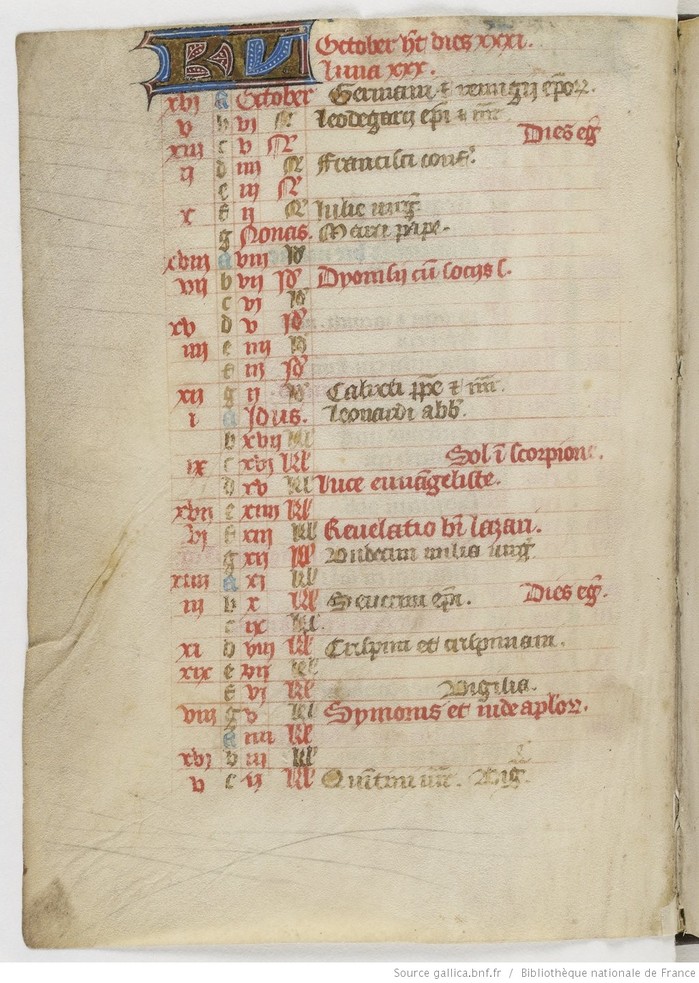
The Very Small Hours of Anne de Bretagne, Bibliothèque nationale de France Nouvelle acquisition latine 3120, is a fascinating tiny use of Rome book of hours from the last 15th Century. It was made in Paris and illuminated by Jean d'Ypres. The calendar is not complete, but very full, with 259 saints and 60 in gold. There are some interesting liturgical notes in the calendar, like the comment "Ultimu[m] Pascha" (the last possible day for Easter) April 24th (f.5v below). Note that it is right-justified with line-filler on the left. This is common throughout the calendar for liturgical notes, Vigils and Zodiac indications. (See in the DB: 142)
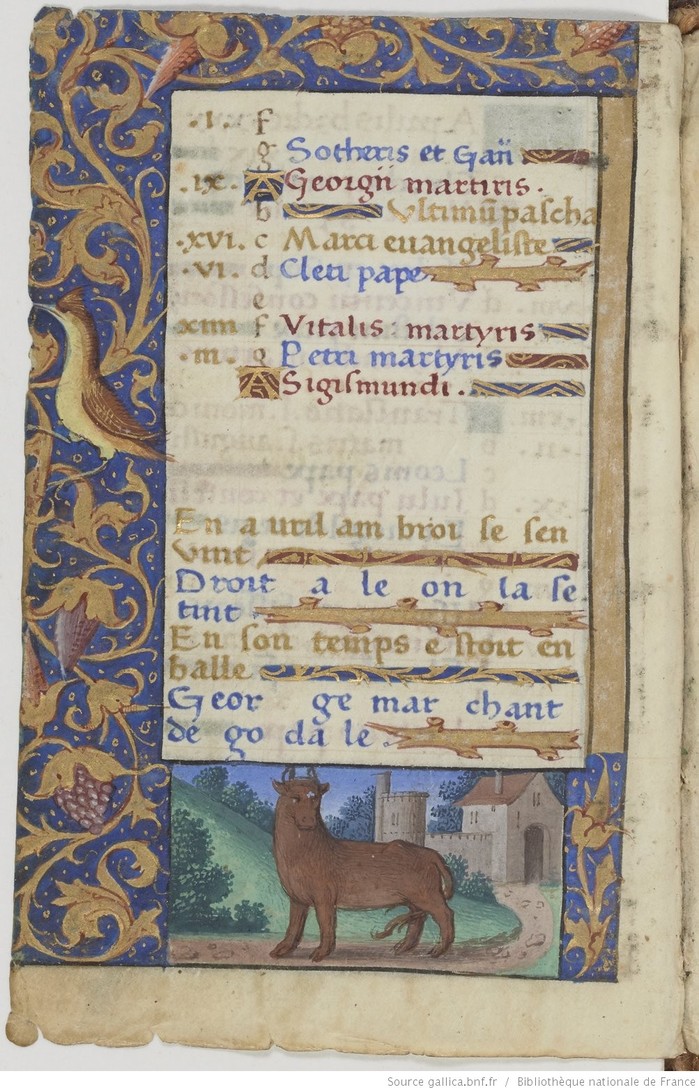
Bibliothèque nationale de France Nouvelle acquisition latine 3210, known as the Hours of Jean de Chateauneuf, is a Book from northern France made around the end of the 15th Century. It has a series of lovely miniatures, painted by Georges Trubert, tending towards shades of blue. The calendar is complete, unusual for a Use of Rome book, and again gives blue primacy, it is the color of the most important saints. The one flaw is that the blue ink is not as stable as the brown and red used for the rest of the entries and has faded to illegibility on some of the pages, see the first name on September (f.5r) below. There are also an unusually large number, 53, of unidentified saints. Further work is needed
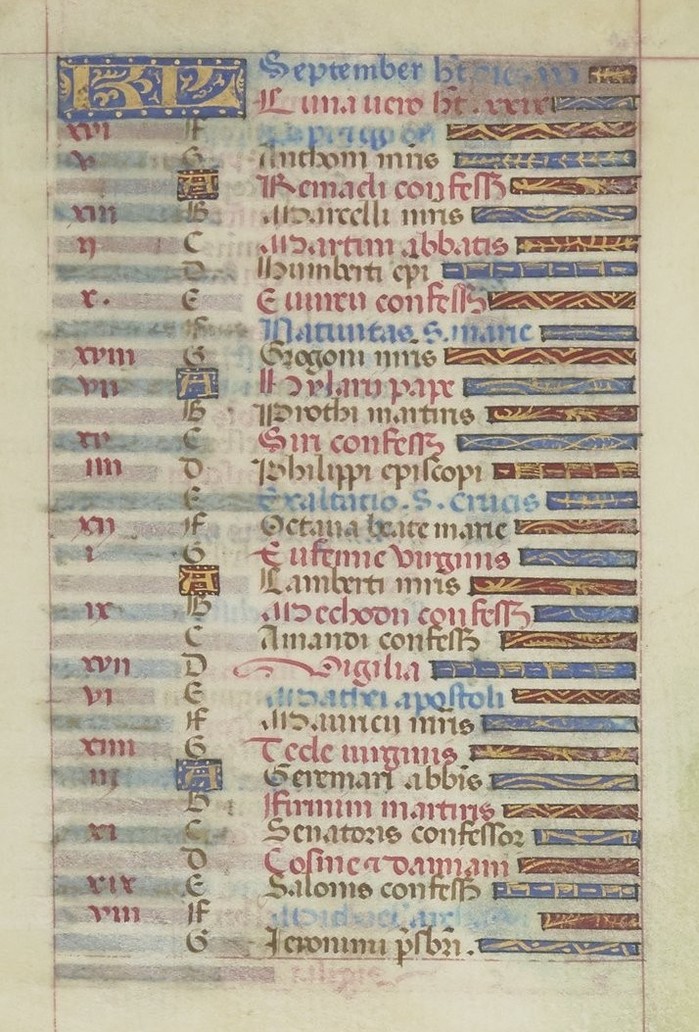
This manuscript, Bibliothèque nationale de France Latin 1168, is the first Use of Chalon in the database. Chalon in this case is Chalon-sur-Saône, a small city originally under the Archbishop of Lyon. The calendar is a complete one in red and black with practically no decoration at all, despite there being some lovely borderd miniatures in the rest of the book. There are some unusual saints in the list, April(see the first half, f4r below) for example has 10 unlisted names.
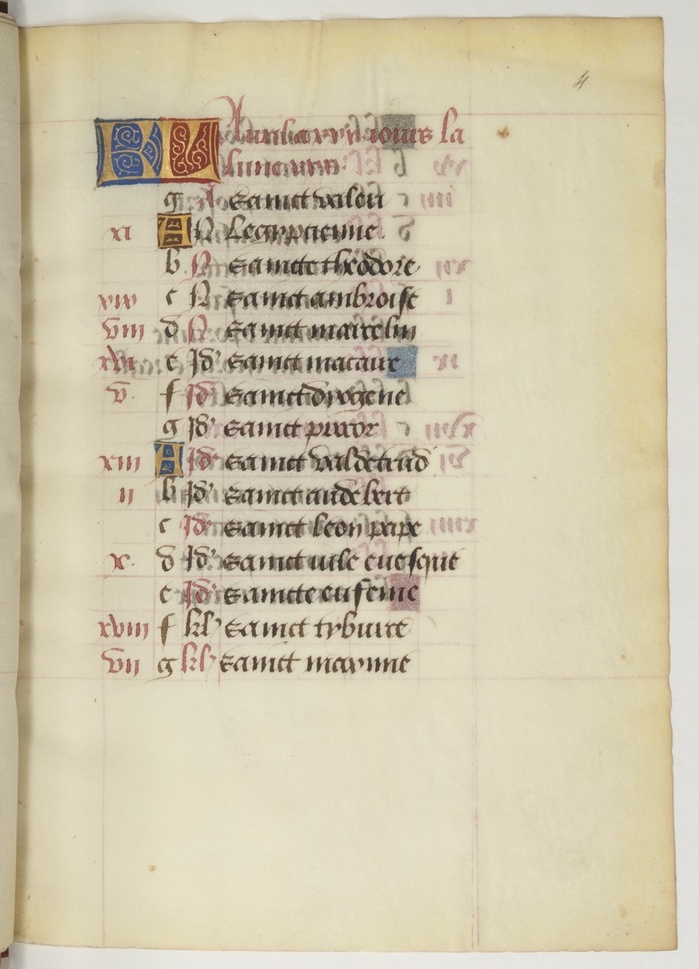
The Hours of Marguerite d'Orléans, Bibliothèque nationale de France MS Latin 1168b, is a lavishly illuminated Use of Rome book. The calendar has some unusual features including a pattern of red-red-blue-blue, in additional to the more common red-blue. The second page for March, f.3v, is a good example
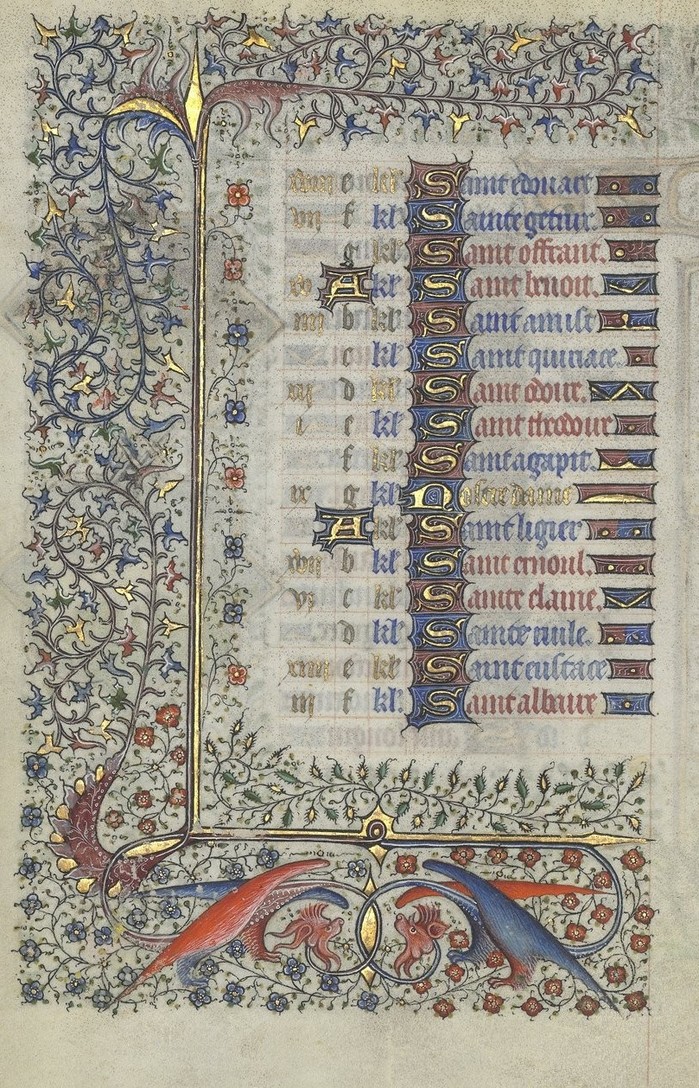
After verifying some readings from the printed fascimile, the Grande Heures de Rohan, MS Latin 9471 from the Bibliothèque nationale de France has been added to the DB. This is a spectacular piece, related to the de Buz hours (Houghton MS Richardson 42), and has three full pages per month. Oddly the calendar itself is somewhat error prone, including a day, April 17 (see below, f.6r-v) which was just duplicated in the calendar.
